-
- PCB TYPE
- PRINTED CIRCUIT BOARD PROTOTYPE ALUMINUM PRINTED CIRCUIT BOARD R&F PCB FPC HIGH FREQUENCY PCB HIGH-TG PCB HEAVY COPPER PCB HDI PCB PCB FOR LIGHTING METAL CORE PCB
time:Jul 17. 2025, 10:12:53
Aluminum printed circuit boards (PCBs) have solidified their position as indispensable components in modern electronics, driven by their unique combination of thermal efficiency, mechanical resilience, and design flexibility. As industries push toward higher power densities, miniaturization, and sustainability, aluminum PCBs continue to evolve, integrating innovative materials and manufacturing techniques. This article explores the latest advancements in aluminum PCB technology, focusing on material breakthroughs, adaptive design strategies, emerging application landscapes, and eco-conscious manufacturing practices that define the next generation of these critical components.
Material Innovations Redefining Aluminum PCB Performance
Eco-Friendly Aluminum Alloys
Sustainability has become a cornerstone of material development for aluminum PCBs:
Recycled Aluminum Composites: Manufacturers are increasingly utilizing post-industrial aluminum scrap, processed to retain 95% of the thermal conductivity of virgin alloys. These composites, blended with trace elements like magnesium, maintain mechanical strength while reducing carbon footprints by 30–40% compared to traditional materials.
Corrosion-Resistant Formulations: New 5xxx series alloys, enhanced with chromium and manganese additives, exhibit superior resistance to humidity and chemical exposure. This makes them ideal for marine electronics, outdoor sensors, and industrial equipment operating in harsh environments.
Lightweight High-Strength Alloys: Advanced 7xxx series variants, incorporating scandium for grain refinement, achieve 20% higher tensile strength than conventional aluminum PCBs. This allows for thinner substrates in weight-critical applications such as drones, portable medical devices, and aerospace components.
Next-Gen Dielectric Materials
The dielectric layer, a critical interface between aluminum substrates and copper circuits, has seen significant innovation:
Bio-Based Epoxy Derivatives: Plant-derived epoxy resins, reinforced with cellulose nanocrystals, offer comparable thermal conductivity to petroleum-based alternatives while reducing volatile organic compound (VOC) emissions during manufacturing. These materials are gaining traction in consumer electronics and green energy systems.
Thermo-Responsive Polymers: Dielectrics engineered to adjust their thermal expansion properties at specific temperature thresholds minimize stress between aluminum cores and copper layers during thermal cycling. This breakthrough enhances reliability in high-power applications like EV battery management systems and industrial motor drives.
Ceramic-Polymer Hybrids: Nanoscale ceramic particles (aluminum oxide, silicon nitride) dispersed in polymer matrices create dielectrics that balance electrical insulation with efficient heat transfer. These hybrids support stable performance in both high-frequency (6G prototypes) and high-temperature (industrial furnaces) environments.
Copper Integration for Enhanced Conductivity
Copper layers in aluminum PCBs are evolving beyond traditional foil designs:
Graphene-Coated Copper: Thin graphene overlays on copper surfaces reduce electrical resistance by 15% and improve thermal coupling with dielectric layers. This innovation is particularly valuable in high-speed digital circuits and RF applications where signal integrity is paramount.
Patterned Copper Architectures: Laser-etched copper traces with optimized geometries (e.g., serpentine paths) enhance heat spreading while maintaining current-carrying capacity. This design approach is critical for compact power modules in renewable energy inverters.
Oxidation-Resistant Coatings: Atomic layer deposition (ALD) of aluminum oxide on copper surfaces prevents corrosion without compromising conductivity, extending PCB lifespan in humid or corrosive environments.
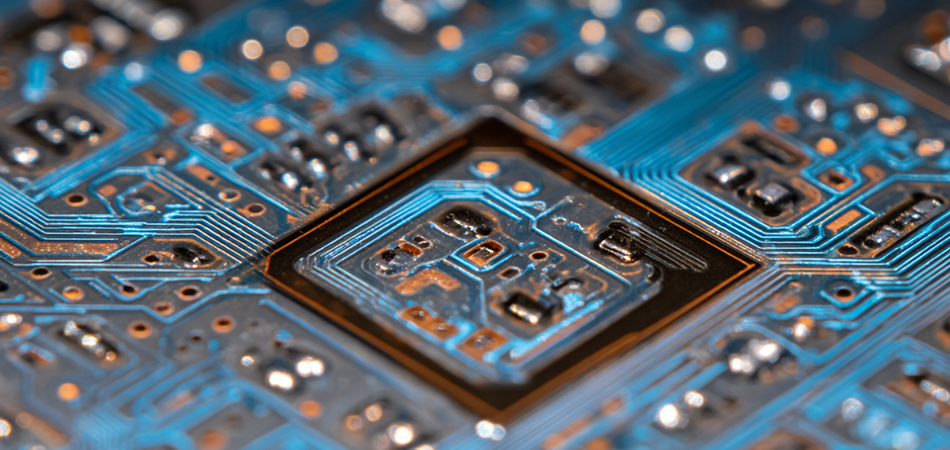
Adaptive Design Strategies for Diverse Environments
Flexible Aluminum PCBs
The demand for form factor versatility has driven advancements in flexible aluminum PCB designs:
Thin-Film Aluminum Substrates: Rollable aluminum cores (≤0.1mm thick) paired with elastomeric dielectrics enable PCBs that withstand 100,000+ bending cycles. These are revolutionizing wearable health monitors, curved automotive displays, and conformable sensors for industrial pipes.
Hybrid Rigid-Flex Structures: Segmented designs combining rigid aluminum sections (for heat dissipation) with flexible polyimide segments (for movement) support dynamic applications like robotic arms and foldable smartphones. The transition zones between rigid and flexible regions are reinforced with micro-reinforced adhesives to prevent fatigue.
3D-Conformal Shaping: Press-forming techniques create aluminum PCBs with complex 3D geometries, integrating cooling fins directly into the substrate for LED lighting and aerospace avionics. This eliminates the need for separate heat sinks, reducing weight and assembly complexity.
Smart Thermal Management Integration
Aluminum PCBs are increasingly incorporating intelligent thermal features:
Embedded Thermal Sensors: Thin-film thermistors integrated within the aluminum substrate provide real-time temperature data, enabling active cooling adjustments in high-power systems like data center servers and laser diodes.
Phase-Change Material (PCM) Integration: Microencapsulated PCMs within the dielectric layer absorb excess heat during peak operation, releasing it gradually during low-load periods. This passive cooling mechanism is ideal for intermittently high-power devices such as radar transceivers.
Directional Heat Paths: Anisotropic thermal conductors (e.g., vertically aligned carbon nanotubes) embedded in the dielectric layer direct heat toward aluminum cores, reducing hotspots in asymmetrically loaded PCBs like LED video walls.
High-Frequency Optimization
As electronics transition to higher frequency bands, aluminum PCBs are adapting:
Low-Loss Dielectric Combinations: Ceramic-filled dielectrics with dielectric constants (Dk) stabilized across frequency ranges (1–100 GHz) minimize signal attenuation in 6G research platforms and satellite communication systems.
Controlled Impedance Traces: Precision-etched copper lines with consistent cross-sections, paired with aluminum substrate grounding planes, ensure stable impedance in high-speed digital circuits. This is critical for reducing signal reflection in automotive radar and IoT gateways.
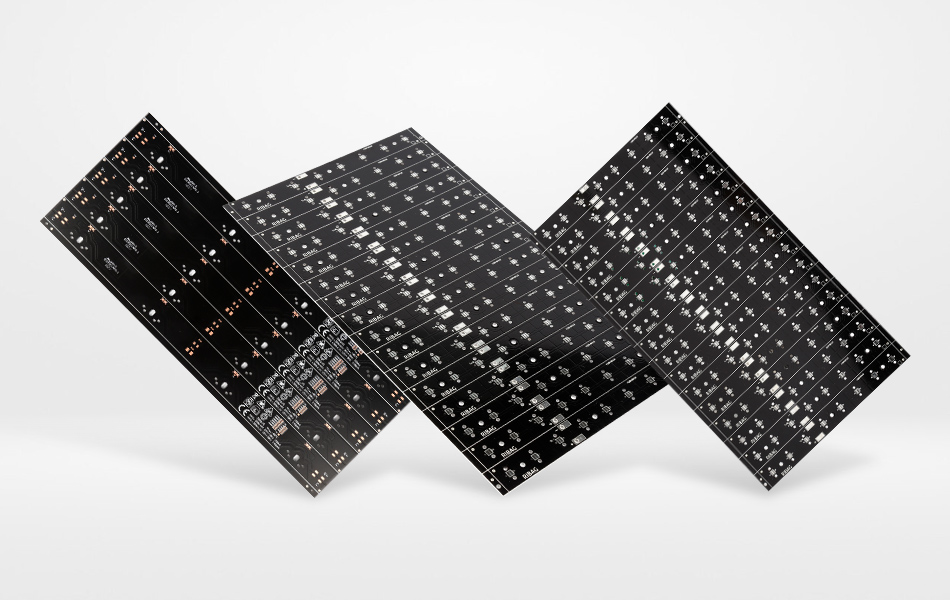
Emerging Application Landscapes for Aluminum PCBs
Renewable Energy Systems
Aluminum PCBs are enabling more efficient green energy technologies:
Solar Microinverters: Corrosion-resistant aluminum substrates with high-thermal-conductivity dielectrics manage heat in distributed solar systems, improving energy conversion efficiency by reducing thermal degradation.
Hydrogen Fuel Cell Controllers: Aluminum PCBs with chemical-resistant coatings withstand humid, hydrogen-rich environments in fuel cell stacks, ensuring reliable operation of power management electronics.
Wind Turbine Sensors: Vibration-resistant aluminum PCBs with flexible sections endure mechanical stress in turbine nacelles, supporting real-time monitoring of rotor performance and energy output.
Medical and Life Sciences
The medical industry benefits from aluminum PCBs’ precision and reliability:
Portable Diagnostic Devices: Lightweight aluminum PCBs with low-power consumption enable compact, battery-operated tools for point-of-care testing, where portability and durability are critical.
Implantable Electronics: Biocompatible aluminum alloys (coated with titanium nitride) in miniaturized PCBs support long-term operation of pacemakers and neurostimulators, with thermal management preventing tissue damage.
Laboratory Automation: High-precision aluminum PCBs in robotic liquid handlers ensure stable performance of sensors and actuators, reducing errors in drug discovery and clinical diagnostics.
Space and Defense Electronics
Aluminum PCBs are meeting the rigorous demands of extreme environments:
Small Satellite (CubeSat) Power Systems: Lightweight aluminum substrates reduce launch weight while dissipating heat from solar panel converters, critical for extending mission lifespans in low Earth orbit.
Radar and Communication Systems: Radiation-hardened aluminum PCBs with specialized dielectrics resist cosmic radiation damage, ensuring signal integrity in deep-space probes and military communication gear.
Unmanned Aerial Vehicles (UAVs): High-strength aluminum PCBs withstand temperature fluctuations and vibration in UAV avionics, supporting navigation, imaging, and data transmission systems.
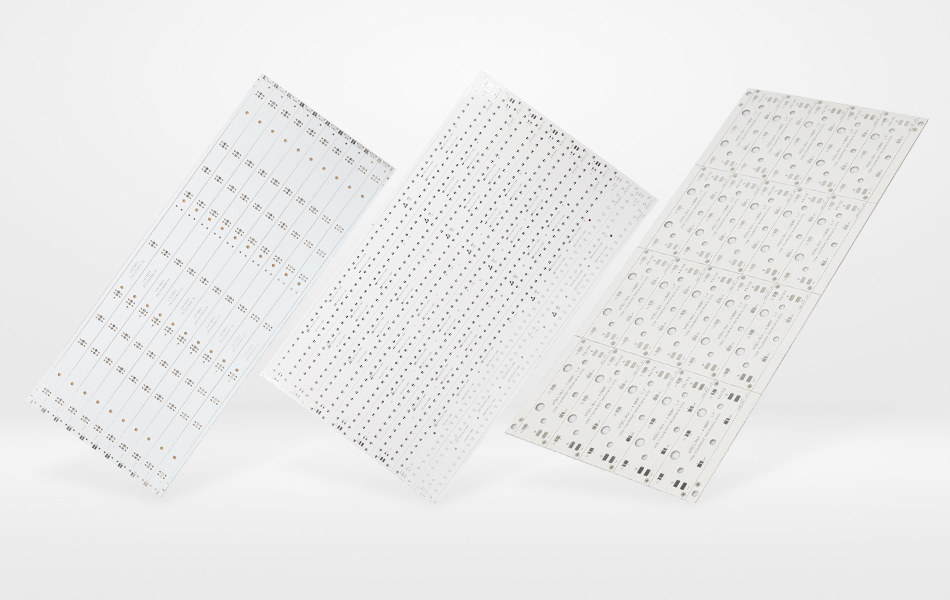
Sustainable Manufacturing Practices in Aluminum PCB Production
Circular Material Flows
Manufacturers are adopting closed-loop approaches to reduce waste:
Aluminum Recovery Systems: In-house recycling facilities extract aluminum from production scrap, reprocessing it into new substrates with minimal loss of thermal conductivity. This reduces reliance on virgin aluminum and cuts raw material costs by 25%.
Dielectric Recycling: Chemical processes separate ceramic fillers from polymer matrices in end-of-life PCBs, allowing reuse of ceramics in new dielectric formulations. This reduces landfill waste from electronic components.
Copper Reclamation: Hydrometallurgical techniques recover copper from etched PCBs with 99% purity, avoiding the energy-intensive smelting process and lowering carbon emissions.
Energy-Efficient Production
Innovations in manufacturing reduce environmental impact:
Solar-Powered Lamination Lines: Renewable energy integration in production facilities powers 60–70% of lamination and curing processes, reducing reliance on fossil fuels.
Low-Temperature Bonding: New adhesive formulations enable aluminum-dielectric bonding at 120°C (down from 180°C), cutting energy use in lamination by 40% without compromising bond strength.
Dry Processing Techniques: Plasma etching replaces chemical baths in copper patterning, eliminating wastewater and hazardous waste disposal. This aligns with strict environmental regulations in regions like the EU and California.
Eco-Certified Supply Chains
Brands are prioritizing sustainability across their value chains:
Responsible Aluminum Sourcing: Partnerships with aluminum smelters using hydroelectric or wind energy ensure aluminum cores have low embodied carbon, appealing to eco-conscious industries like electric mobility and green construction.
VOC-Free Coatings: Water-based dielectric coatings and adhesives replace solvent-based alternatives, reducing air pollution and improving workplace safety during manufacturing.
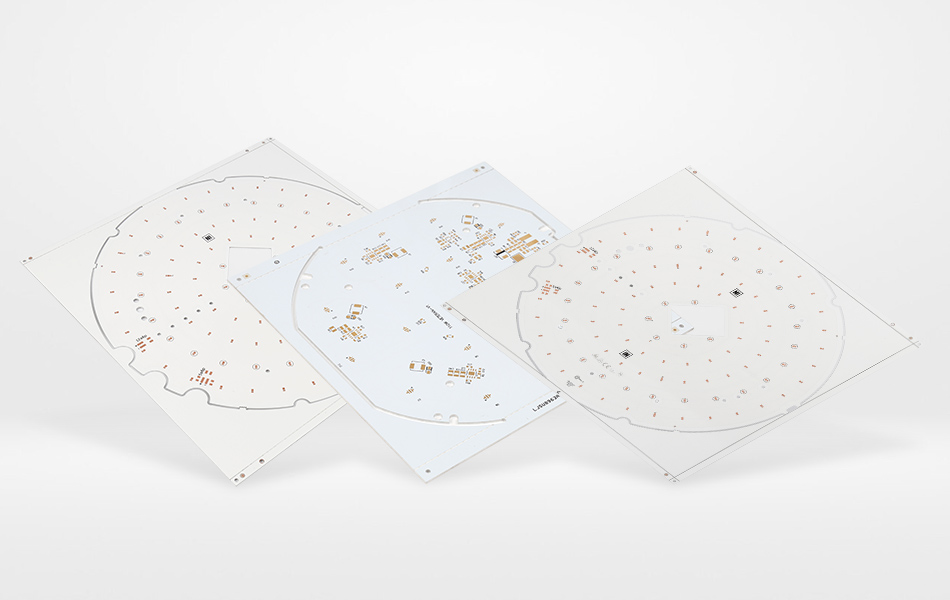
Future Trends Shaping Aluminum PCB Development
Atomic-Level Material Engineering
Research is pushing the boundaries of material performance:
Graphene-Aluminum Hybrids: Lab-scale experiments with graphene-reinforced aluminum alloys show potential for 50% higher thermal conductivity, which could enable ultra-thin PCBs for quantum computing cooling systems.
2D Material Integration: Hexagonal boron nitride (hBN) layers between aluminum and dielectric layers reduce interfacial thermal resistance, enhancing heat transfer in high-power applications.
Digital Twin Design Platforms
AI-driven tools are transforming PCB development:
Predictive Thermal Modeling: Machine learning algorithms analyze component placement and material properties to simulate heat distribution, optimizing aluminum substrate thickness and via placement before prototyping. This reduces design cycles by 30%.
Generative Design Tools: AI generates aluminum PCB layouts that balance thermal efficiency, mechanical strength, and cost, considering constraints like component density and environmental conditions.
Integration with Smart Systems
Aluminum PCBs are becoming active components in intelligent electronics:
Self-Monitoring PCBs: Embedded micro-sensors in aluminum substrates detect cracks, corrosion, or thermal degradation, enabling predictive maintenance in critical systems like power grids and medical equipment.
Energy-Harvesting Integration: Thermoelectric generators printed on aluminum PCBs convert waste heat into electricity, powering low-energy sensors in industrial machinery and smart buildings.
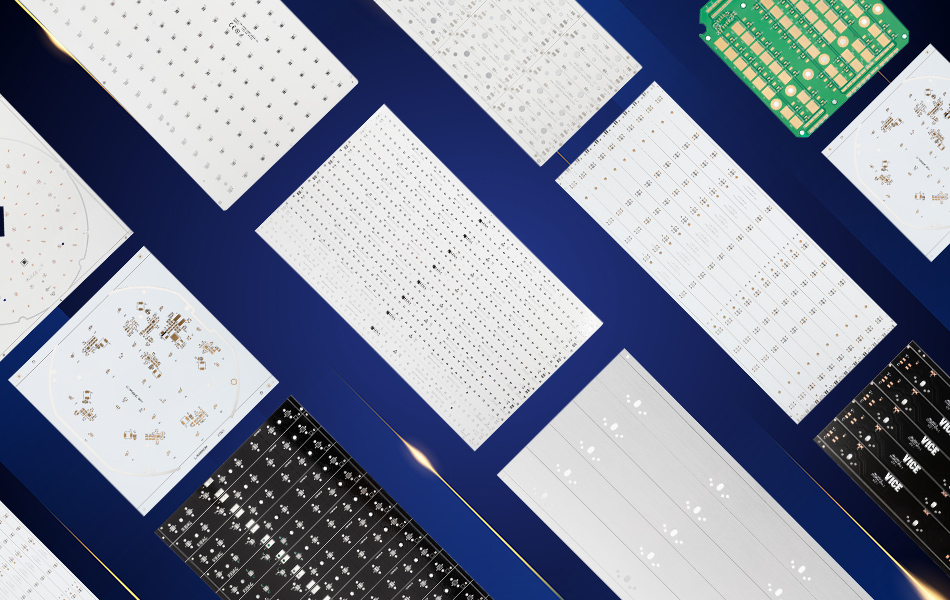
Conclusion
Aluminum PCBs continue to evolve as a cornerstone of modern electronics, driven by advancements in material science, adaptive design, and sustainable manufacturing. Their ability to balance thermal management, mechanical resilience, and environmental responsibility makes them indispensable across industries—from renewable energy and healthcare to aerospace and consumer electronics. As 2025 unfolds, the integration of eco-friendly materials, smart thermal features, and circular production practices will further solidify aluminum PCBs as a key enabler of the next generation of high-performance, sustainable electronic systems. For engineers and manufacturers, embracing these innovations will be critical to meeting the demands of an increasingly connected, energy-efficient world.

Got project ready to assembly? Contact us: info@apollopcb.com



We're not around but we still want to hear from you! Leave us a note:

Leave Message to APOLLOPCB
